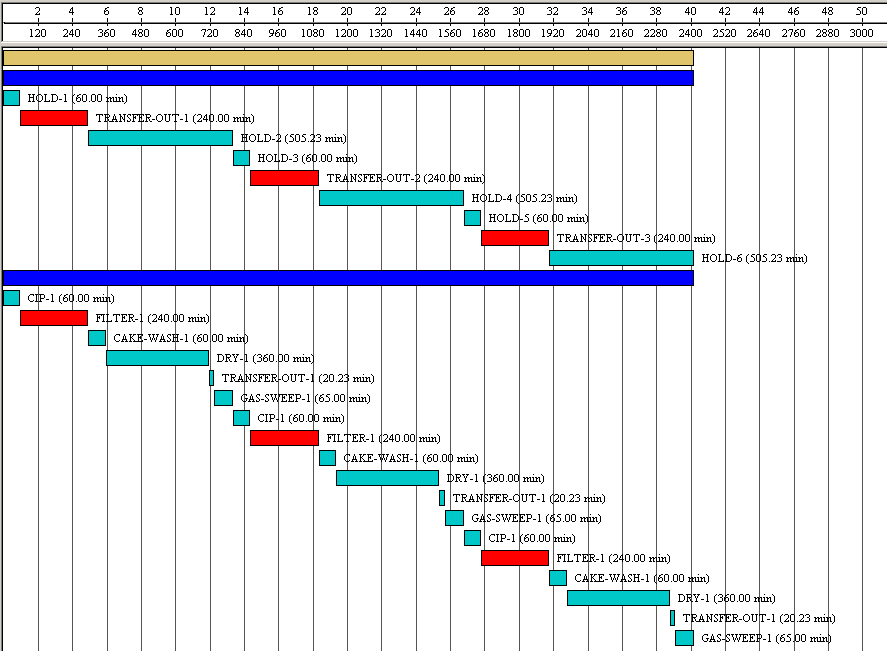

This dialog appears when you click on the Setup... button when choosing to have the duration of an operation (slave) be determined by the duration of another (master).
The operation you choose as the master, may exist in the same procedure as the slave or in another procedure. To remind you which operation you are setting specifications for, the slave operation’s name, unit procedure, and host equipment are mentioned near the top of the dialog.
Once you have specified the unit procedure that includes the master operation, then you must specify which operation(s) will dictate the duration of the slave operation. You have two choices:
1. Single master operation. In that case the three parameters of the slave's duration (setup time, process time and turnaround time) are matched one-to-one to the master's operation parameters. If the master operation exists in a multi-cycle procedure, then you have two choices for how to determine the process time of the slave operation:
a) If you check the option named ‘Match Duration per Cycle’, then the process time of the slave operation will equal the master’s process time per cycle (even if the master is in a multi-cycle procedure).
b) If you do not check the option named ‘Match Duration per Cycle’, then the slave operation’s process time will be set to span the time from the start of the process time of the first cycle to the end of the process time in the last cycle.
2. You can choose a string (sequence) of operations, determined by a starting-master operation and an ending-master operation (in the same procedure). In that case, the setup time of the slave will be matched to the setup time of the starting-master operation. The turnaround time of the slave will be matched to the turnaround of the ending-master operation. Finally, the process time of the slave, will be matched as follows:
a) If you check the option named ‘Match Duration per Cycle’, then the process time of the slave will match the span between the start of the process time of the starting-master operation and the end of the ending-master operation during one cycle alone.
b) If you do not check the option named ‘Match Duration per Cycle’, then the process time of the slave will match the span between the start of the process time of the starting-master operation in the 1st cycle and the end of the ending-master operation in the last cycle.
As an example that demonstrates the above options, consider the following two procedure simple recipe:
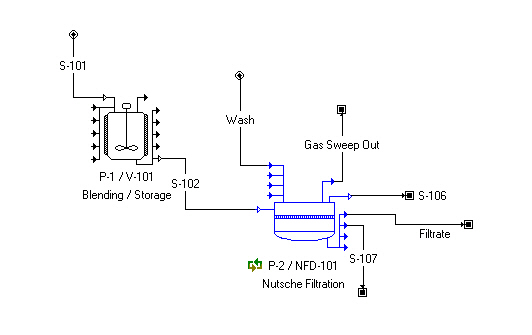
The objective is to have the transfer out operation from the Blending Tank (V-101) match the filtration operation in P-2. Since the amount being transferred is determined that it cannot be handled in one cycle by the Nutsche Filter, the number of cycles in the P-2 procedure has been set to 3.
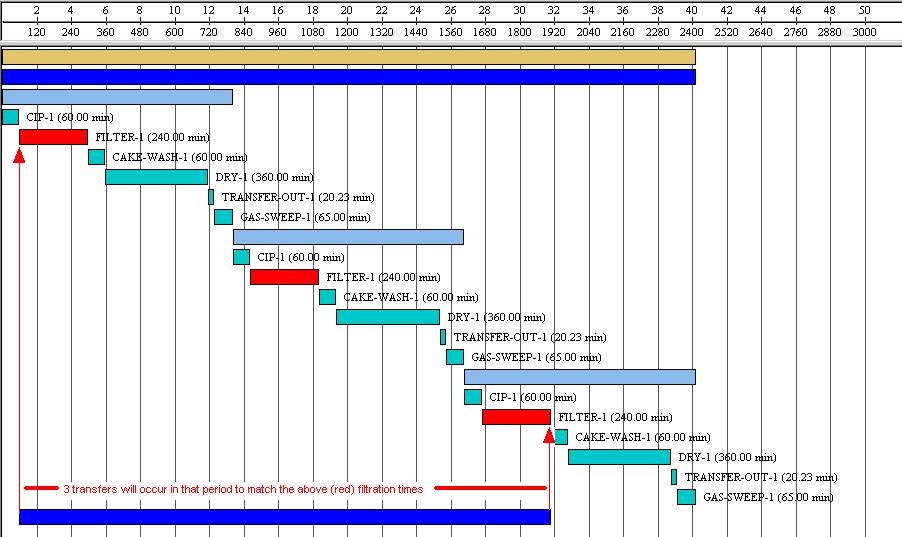
As you can see from the above Gantt chart, the transfers out of V-101 will have to match the filtration times as they occur in P-2. Clearly, this is a case where we need to define a master-slave relationship, where the master operation (dictating the timing) would be the filtration operation in P-2, and the slave will be the transfer-out operation in P-1. Notice that in our example there is CIP operation that occurs before the filtration of operation in each cycle, and there is a sequence of other operations that deal with the cake (Cake Wash, Drying, Cake Transfer-Out, Gas-Sweep) and then the filtration cycle is ready to start over. Depending on how accurate one may choose to represent the time-match between the master and the slave operation you can follow one of the next approaches.
If you do not particularly care to simulate the duration of the transfer operations to match identically to the filtration times, but you only need to capture the fact that vessel V-101 is 'busy' during the entire period, then you may follow this approach. Let the number of cycles in P-1 stay as 1, and setup the master-slave relationship from the transfer out operation's dialog as follows:

As you can see, in this approach we have the ‘Match Duration per Cycle’ option unchecked. In this case, the duration of the transfer operation will be set to equal the entire span as shown in the previous Gantt Chart. Therefore, the full Gantt chart in this case will be:

First, set the number of cycles of the transfer procedure (P-1) to equal the number of cycles of the filtration procedure (in this case 3). To find out how to change the number of cycles for a procedure, see Procedure Data Dialog: Scheduling Tab (Batch Process).
Next, since there some operations executing before and after the filtration operation in each of the P-2's cycle, we will include a Hold operation before the transfer out and another Hold operation after the transfer out to match the dead time before and after the transfer out operation. Since there's only one operation happening before the filtration operation (the CIP cleaning) we will make the before-transfer-out hold a slave directly to that CIP operation (on a per-cycle basis), so the master-slave relationship will be as follows
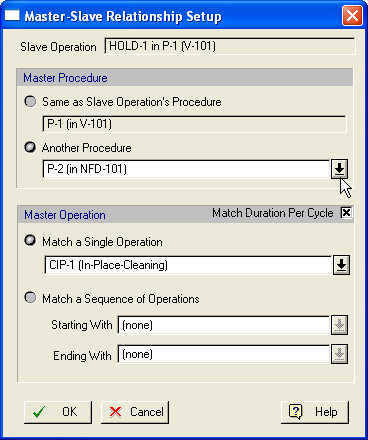
For the hold operation after the transfer out, we need to make it match a sequence of operations that happen after the filtration (cake wash, dry, cake transfer out and gas sweep) again on a per-cycle basis. To setup this master-slave relationship we will use the multiple master option and use as the start-master the cake wash operation in P-2 and as the end-master the gas sweep operation in P-2:
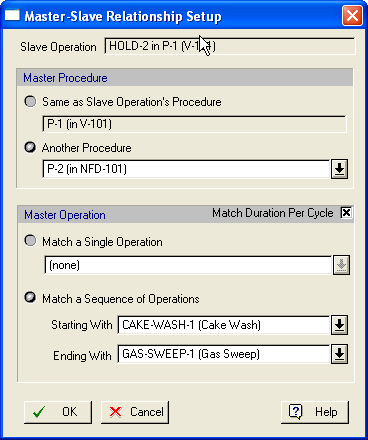
After the above setup, the Gantt chart will be as follows:
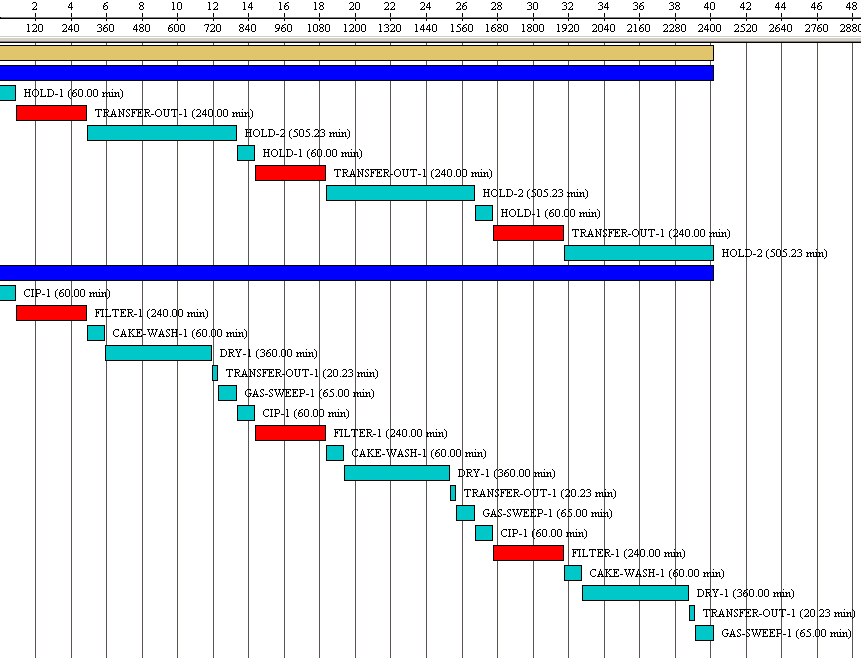
In this second option, we maintain the number of cycles of the source procedure (P-1) to 1, but in a similar spirit of the above case (2a) we will introduce a hold operation before the filtration and a hold operation after the filtration that we will match (on a per cycle basis) - same as in 2a above. To reproduce the fact that the same sequence happens three times, we will add two more times the same sequence of hold / transfer-out / hold. This time, the duration of hold will be made to match the duration of the first hold in P-1.

The duration of the second transfer out will be made to match the duration of the first transfer out:

And finally, the duration of the follow-up hold will be made to match the duration of the second hold in P-1:
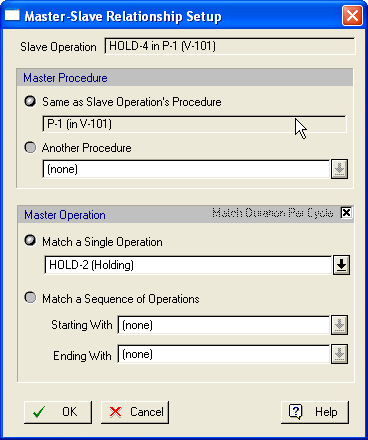
After repeating the last three steps once more, then we can have a similar Gantt chart as above, but now we only keep one cycle.
